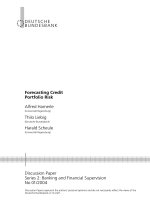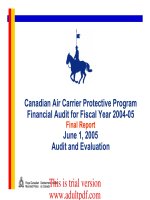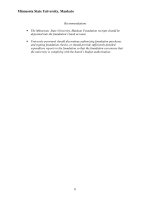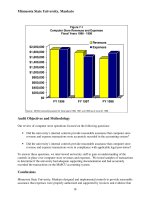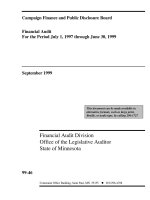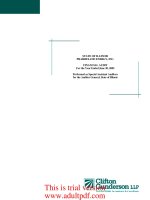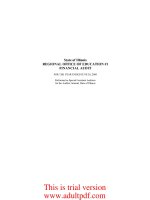Financial information for managemetn paper 1 2 2005 answers
Bạn đang xem bản rút gọn của tài liệu. Xem và tải ngay bản đầy đủ của tài liệu tại đây (89.4 KB, 10 trang )
Answers
Part 1 Examination – Paper 1.2
Financial Information for Management
December 2005 Answers
Section A
1
2
3
4
5
6
7
8
9
10
11
12
13
14
15
16
17
18
19
20
21
22
23
24
25
D
C
C
C
B
D
C
C
A
B
A
B
C
D
A
C
D
A
A
C
D
D
D
D
B
1
D
2
C
1,700 units – Breakeven level units (1,200) = 500 units
3
C
Contribution per unit = 22 ÷ 0·55 × 0·45 = £18
Breakeven point = 198,000 ÷ 18 = 11,000
4
C
Variable cost per unit = [(170,000 – 5,000) – 140,000)] ÷ (22,000 –17,000) = £5
Total fixed cost above 18,000 units = 170,000 – (22,000 × 5) = £60,000
Total cost of 20,000 units = (20,000 × 5) + 60,000 = £160,000
5
B
6
D
7
C
Weighted average after 13th = [(200 × 9,300 ÷ 300) + (600 × 33)] ÷ (200 + 600) = £32·50
Closing stock valuation = 300 × 32·50 = £9,750
8
C
EOQ = [(2 × 160 × 9,000) ÷ (0·08 × 40)]0·5 = 949
9
A
10 B
17
11 A
Absorption rate = 247,500 ÷ 30,000 = £8·25
Absorbed cost = 28,000 × 8·25 = £231,000
Actual cost =
£238,000
Under absorption =
£7,000
12 B
Marginal costing profit = 36,000 – (2,000 × 63,000 ÷ 14,000) = £27,000
13 C
Process F: expected output = 0·92 × 65,000 =
actual output =
∴ abnormal loss
Process G: expected output = 0·95 × 37,500 =
actual output =
∴ abnormal gain
14 D
Actual hours at standard rate (27,000 × 8·50)
Standard hours of production at standard rate
∴Labour efficiency variance is
15 A
Sales price variance:
Actual sales at standard price (4,650 × 6)
Actual sales at actual price
Favourable price variance
Adverse sales volume contribution variance:
350 units × (6 × 0·60)
59,800
58,900
35,625
35,700
£
229,500
253,980
––––––––
24,480 Favourable
––––––––
£
27,900
30,225
–––––––
2,325
–––––––
1,260
16 C
17 D
18 A
19 A
Coefficient of determination = r2 = 0·6 × 0·6 = 0·36 = 36%
20 C
21 D
4,000 × [(20,000 ÷ 2,500) × 1·025] = £32,800
22 D
Production (units):
J: (6,000 – 100 + 300) =
K: (4,000 – 400 + 200) =
6,200
3,800
––––––
10,000
––––––
Joint costs apportioned to J: (6,200 ÷ 10,000) × 110,000 = £68,200
23 D
Material required to meet maximum demand:
6,000 × (13 ÷ 4) + 8,000 × (19 ÷ 4) = 57,500 litres
Material available:
50,000 litres
∴ Material is a limiting factor
Labour required to meet maximum demand:
6,000 × (35 ÷ 7) + 8,000 × (28 ÷ 7) = 62,000 hours
Labour available:
60,000 hours
∴ Labour is a limiting factor
18
24 D
Profits maximised when: marginal revenue (MR) = marginal cost (MC)
MR = 50 – 0·05Q
MC = 15
MR = MC
∴ 50 – 0·05Q = 15
and
Q = 700
P = 50 – (0·025 × 700) = £32·50
25 B
When P = 20
then
and
20 = 50 – 0·025Q
Q = 1,200
£
Total revenue (P × Q) = 1,200 × 20 = 24,000
Less total costs 2,000 + (15 × 1,200) = 20,000
––––––
∴Profit
4,000
––––––
Section B
1
(a)
Using the high-low method:
Units
120,000 (W1)
102,000
––––––––
18,000
––––––––
Total cost (£)
700,000
619,000
––––––––
81,000
––––––––
Working (W1)
Full capacity = 102,000 ÷ 0·85 = 120,000
(i)
Variable cost per unit = 81,000 ÷ 18,000 = £4·50
(ii)
Total fixed costs = 700,000 – (120,000 × 4·50) = £160,000
(iii) Selling price per unit = variable cost per unit ÷ (1·00 – 0·40)
= 4·50 ÷ 0·6 = £7·50
(iv) Contribution per unit = (7·50 – 4·50) = £3·00
(b)
New business:
Selling price (0·80 × 7·50)
Less variable cost
£ per unit
6·00
(4·50)
–––––
1·50
–––––
Contribution
Contribution from 15,000 units (15,000 × 1·50)
Less opportunity cost (15,000 ÷ 6) × £3·00
Net increase in contribution (and profit)
(c)
2
£
22,500
(7,500)
–––––––
15,000
–––––––
An opportunity cost is the cost of the best alternative forgone in a situation of choice. Opportunity costs are relevant costs.
In the situation of Pointdextre Ltd, if it goes ahead with the new business (that is the decision) then it will lose (forgo) the
contribution from some existing sales. This lost contribution is an opportunity cost relevant to the decision.
(a)
Process I
Input
Conversion
Abnormal gain (W2)
Litres
50,000
1,000
–––––––
51,000
–––––––
£
365,000
256,000
13,500
––––––––
634,500
––––––––
Output (W1)
Normal loss (0·08 × 50,000)
Workings:
W1 Cost per litre (365,000 + 256,000) ÷ (50,000 × 0·92) = £13·50
Output value = 47,000 × 13·50 = £634,500
W2 Abnormal gain = 47,000 – (50,000 × 0·92) = 1,000
Valuation (1,000 × 13·50) = £13,500
19
Litres
47,000
4,000
£
634,500
–
–––––––
51,000
–––––––
––––––––
634,500
––––––––
(b)
Workings:
Cost per equivalent litre (EL):
Completion of opening WIP
Started and finished within the month (50,000 – 5,000)
Work done so far on closing WIP
Conversion
EL
3,000
45,000
1,000
–––––––
49,000
–––––––
∴Cost per EL = 392,000 ÷ 49,000 = £8
(c)
3
(i)
Output = 80,000 + (45,000 × 13·50) + (48,000 × 8·00) = £1,071,500
(ii)
Closing WIP = (2,000 × 13·50) + (1,000 × 8·00) = £35,000
The disposal costs would be debited to the process account. Alternatively, they could be shown as a negative value on the
credit side of the account.
Let X = the number of units of product X
and Y = the number of units of product Y
Contribution per unit:
Product X
£ per unit
60
(45)
––––
15
––––
Selling price
Less variable cost
Contribution
Product Y
£ per unit
25
(13)
––––
12
––––
Objective function:
Total contribution = 15X + 12Y
Constraints:
3X + Y ≤ 4,200
Material (£5 per kg)
Labour (£6 per hour)
4X + 0·5Y ≤ 3,000
X, Y ≥ 0
Non negative
Using a graphical approach, the constraints (solid lines) and the objective function (dotted line) can be shown as follows:
Y
units
6,000
Labour
4,200 A
B
Material
750
0
C
600 750
X units
1,400
Note: the objective function line has been shown on the above graph for a total contribution of £9,000 (assumed). Thus 15X +
12Y = 9,000.
Therefore when X = 0, Y = (9,000 ÷ 12) = 750
and when Y = 0, X = (9,000 ÷ 15) = 600
The ‘feasible region’ is the area OABC shown on the graph. If the objective function line is moved away from the origin (at the
same gradient) the last point it reaches in the feasible region is point A which must therefore be the optimal point.
Therefore the optimal production is to produce and sell 4,200 units of product Y and no units of product X.
20
An alternative approach would be to calculate the total contributions at points A, B and C shown on the graph and select the point
giving the highest total contribution, as follows:
Point A
Total contribution from 4,200 units of Y is (4,200 × £12) = £50,400
Point B
To find the units at this point, solve the following equations simultaneously:
3X +
Y = 4,200
… (1)
4X + 0·5Y = 3,000
… (2)
From (1)
Y = 4,200 – 3X
Substituting into (2)
4X + 0·5(4,200 – 3X) = 3,000
∴
4X + 2,100 – 1·5X = 3,000
∴
2·5X
= 900
∴
X = 360
Substituting into (1)
(3 × 360) + Y
= 4,200
∴
Y = 3,120
Total contribution from 360 units of X and 3,120 units of Y is (360 × £15) + (3,120 × £12) = £42,840
Point C
Total contribution from 750 units of X is (750 × £15) = £11,250
Point A gives the highest contribution (£50,400 from producing 4,200 units of Y and no units of X) and is therefore the optimal
solution (as before).
4
(a)
Standard cost of actual production [12,500 × (11 + 24 + 18)]
Total variances:
Adverse
Favourable
£
£
Materials (W1)
5,200
Labour (W2)
8,700
Fixed overhead (W3)
5,800
–––––––
––––––
11,000
8,700
–––––––
––––––
Actual cost (142,700 + 291,300 + 230,800)
Workings:
W1
Actual cost
£
142,700
Standard cost of actual production
137,500
Actual cost
291,300
Standard cost of actual production
300,000
Actual cost
230,800
Standard cost of actual production
225,000
£
662,500
2,300 A
––––––––
664,800
––––––––
Variance
£
5,200 A
W2
8,700 F
W3
5,800 A
(b)
£
Expenditure variance:
Actual cost
230,800
Budgeted cost (12,000 × 18)
216,000
Volume variance:
Budgeted cost
216,000
Standard cost of actual production
225,000
£
14,800 A
9,000 F
(c)
The total direct materials and labour variances would be the same under absorption and marginal costing. The total fixed
overhead variance under marginal costing would be different and would be the same as the expenditure variance under
absorption costing (£14,800 A). There is no volume variance under marginal costing as fixed production costs are treated
as period costs and not treated as product costs.
21
5
(a)
Absorption rates:
Cost centre T: (780,000 ÷ 16,250) = £48 per machine hour
Cost centre W: (173,400 ÷ 14,450) = £12 per direct labour hour
(b)
Prime costs:
Direct materials
Direct labour:
Cost centre T
Cost centre W
Production overheads:
Cost centre T: (35 ÷ 60) × 48
Cost centre W: (21 ÷ 6) × 12
(c)
£
10
14
21
––––
45
28
42
––––
115
––––
Products do not pass through service cost centres so the costs of such centres cannot be absorbed directly into products.
Products only pass through production cost centres. Therefore in order to calculate a total production cost per unit, service
cost centre costs have to be reapportioned to production cost centres for absorption.
The method of reapportionment that fully recognises any work that service cost centres do for each is called the reciprocal
method. There are two techniques for applying the reciprocal method – a repeated distribution approach or the use of
simultaneous equations.
22
Part 1 Examination – Paper 1.2
Financial Information for Management
December 2005 Marking Scheme
Marks
Section A
Each of the 25 questions in this section is worth 2 marks
50
–––
Section B
1
(a)
(i)
(ii)
(iii)
(iv)
Variable cost per unit
Total monthly fixed costs
Selling price per unit
Contribution per unit
2
2
1
1
–––
6
(b)
Contribution from new business
Opportunity cost
Net increase in profit
2
11/2
1/
2
–––
4
(c)
Explanation of opportunity cost
Reference to Pointdextre Ltd
1
1
–––
2
–––
12
–––
2
(a)
Input and conversion
Normal loss
Abnormal gain
Output
1
11/2
11/2
1
–––
5
(b)
11/2
1/
2
2
1
–––
Equivalent units for conversion
Cost per equivalent unit for conversion
Valuation of output
Valuation of closing work in progress
5
3
(c)
Debit entry
(a)
Contributions per unit
Objective function
Constraints
2
–––
12
–––
1
1
3
–––
5
(b)
Graph (or total contributions at feasible points)
Optimal plan
3
1
–––
4
–––
9
–––
23
Marks
4
(a)
Total materials variance
Total labour variance
Total fixed overhead variance
Reconciliation statement
1
1
1
1
–––
4
(b)
Expenditure variance
Volume variance
1
1
–––
2
(c)
Direct materials and labour variances the same
Total variance = expenditure variance
No volume variance with reason
1
1
1
–––
3
–––
9
–––
5
(a)
Cost centre T absorption rate
Cost centre W absorption rate
1
1
–––
2
(b)
1/
2
Prime cost
Production overheads (T)
Production overheads (W)
Total unit cost
1
1
1/
2
–––
3
(c)
Reapportionment explanation
Reapportionment method
2
1
–––
3
–––
8
–––
24
